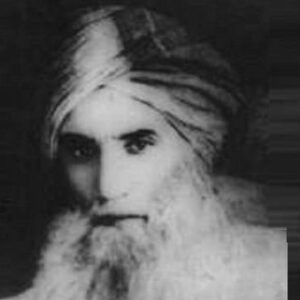Nizamuddin Auliya was Hazrat Khwaja Moinuddin Chishti of Ajmer’s fourth Spiritual Successor (Khalifa). He belonged to the Chishti order, which believed in drawing closer to God by renunciation of the world and service to humanity, and Auliya, like his forefathers, emphasized love as a means of discovering God. From a young age, he had a spiritual bent. He was reared by his mother, who was a highly religious woman, after his father died while he was a tiny child. She made certain that her son memorized the Quran and studied Ahadith (traditions of the Prophet Mohammed). He grew up to be a bright and perceptive young man who excelled in not just religious studies but also mathematics and astronomy. He became a student of the Sufi saint Fariduddin Ganjshakar, also known as Baba Farid, when he was 20 years old. He became close to Baba Farid and received spiritual training as well as lessons in “Awarif-ul-Ma’Arif” (Hazrat Khwaja Shihabuddin Suhrawardi’s unique publication on Sufism) and “Tamheed Abu Shakoor Salmi.” Nizamuddin Auliya became the founder of the Chisti Nizami order after succeeding Baba Farid. He was known for his humility and service to humanity and was regarded as an unrivaled Sufi of his day among all the current Sufi groups.
Childhood and Adolescence
Hazrat Syed Ahmed Bokhari and Bibi Zuleikha gave birth to Nizamuddin Auliya in Badayun, Uttar Pradesh, in 1238. His parents were both deeply religious and devout believers. His father was claimed to have chanted the Islamic kalima shortly after his birth, while his mother’s prayers were said to never go unanswered.
When Auliya’s father died when he was five years old, his mother took it upon herself to make sure that her son had the greatest education possible. She entrusted him to the tutelage of Maulana Allauddin Usooli of Badayun, under whose tutelage the youngster thrived academically.
The little child mastered the seven ways of reciting the holy Quran, as well as Arabic grammar, Ahadith (Prophet Mohammed’s traditions), Tafsir (Quranic commentary), arithmetic, and astronomy. He was also an outstanding debater.
He first heard of the Sufi saint Fariduddin Ganjshakar, also known as Baba Farid, when he was around 16 or 17 years old, and acquired feelings of love and reverence for him right away. His devotion to the baba became stronger over time, and at the age of 20, he traveled to Ajodhan (now Pakpattan Sharif in Pakistan) and became Baba Farid’s student.
Nizamuddin Auliya was pursuing his theology studies in Delhi at the time, thus he did not relocate to Ajodhan. However, he began Sufi devotional activities and prescribed litanies at the same time as his studies. Every year, he traveled to Ajodhan to spend Ramadan in the company of Baba Farid. Baba Farid appointed him as his successor on his third visit.
After the death of Baba Farid, Nizamuddin Auliya became the fourth Spiritual Successor (Khalifa) of Hazrat Khwaja Moinuddin Chishti of Ajmer. He led a life as a Sufi dervish based on the core teachings of Islam and Sufi ideas. His life exemplified the concept of “simple living and elevated thought.”
He eventually settled in Ghiyaspur, a village near Delhi, after staying in various parts of the city. He erected his Khanqah there, which drew individuals from all walks of life from far and wide.
He was deeply committed to assisting the poor, feeding the hungry, and sympathizing with the afflicted. Thousands of hungry and poor individuals ate there every day because his kitchen was constantly open. He personally oversaw the Khanqah guaranteeing that all visitors, regardless of religion, caste, creed, or socioeconomic class, were treated with the utmost hospitality.
He was extraordinarily generous to the underprivileged, although leading a very spartan existence himself. He dressed simply and fasted on a daily basis, eating only a small piece of barley bread and vegetable soup.
Auliya was also a very generous disciple acceptor. He had around 600 khalifas around the world who carried on his heritage. A khalifa is a disciple who has been given the right to take his own disciples in order to continue the spiritual lineage. Nasiruddin Chiragh Dehlavi, who became his spiritual successor, and poet Amir Khusro, who was Auliya’s most beloved disciple, were two of his most prominent disciples.
Major Projects of Nizamuddin Auliya
The Chisti Nizami order was founded by Nizamuddin Auliya. Many of his students went on to become famous Sufis of the Chisti Nizami order, who preached the Sufi message all across the world. Muhammad Hussaini Gisudaraz Bandanawaz, Gulbarga, Shah Niyaz Ahmad Barelvi, Muhiuddin Yousuf Yahya Madani Chishti, and Shah Mohammad Shah are among his descendants and disciples.
Personal History and Legacy
Nizamuddin Auliya never married. He believed his brother Jamaluddin’s descendants to be his own, and after his death, he reared his brother’s son Ibrahim.
He had a deep affection for Prophet Mohammad. He had a vision of the prophet shortly before his death and recognized that his time was running out. He got very ready to leave his worldly body after seeing the vision so that he may be joined with the prophet. He gave up eating during the last 40 days of his life and died on the morning of April 3, 1325.
Estimated net worth
The estimated net worth of Nizamuddin Auliya is unknown.


